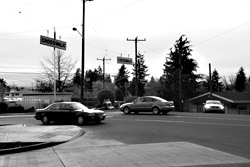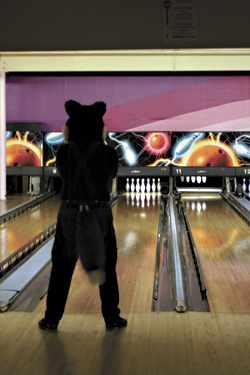Last November, a driver hit and killed pedestrian Matthew “Tatsuo” Nakata, a 29-year-old aide to Seattle City Council member David Della, in a marked crosswalk in West Seattle. Lawmakers gave public eulogies, established a memorial fund in his name, mentioned him prominently when unveiling a pedestrian-safety master plan, and drafted the Matthew “Tatsuo” Nakata Act for driver education on the state level last month.
Meanwhile, Nakata’s family was working to memorialize their lost relative in a different way: They hired an attorney to look into suing the city.
A public-disclosure request shows that the month after Nakata’s death, the Seattle Department of Transportation was contacted by a lawyer acting on behalf of the Nakata clan, whose members reside in Hawaii, Ohio, Texas, and Kentucky. And not just any lawyer, but trial whiz Mike Withey, who, earlier this month, won a $1 million judgment against the city of Seattle stemming from the mass arrests of World Trade Organization protestors in 1999.
In a Dec. 19 letter to SDOT, Withey stated that he was representing Nakata’s brother, Joshua, and requested that the city provide traffic studies relating to the intersection where Tatsuo was killed. In the hands of skilled attorneys, such documents are useful in proving negligence through inept roadway design.
Joshua Nakata didn’t respond to repeated phone messages seeking comment. Withey, who is currently sojourning in a part of Panama where modern communication tools are scarce, responded with a brief e-mail that portends a huge pain in the ass for the city. In this communiqué, he urges criminal prosecution of the driver, new legislation to increase pedestrian safety at crosswalks, and a settlement for the Nakatas.
“This intersection had been studied for over 4 years, had brought many complaints from the neighbors and businesses in the area, and was undoubtedly one of the most dangerous in the entire city,” writes Withey.
But city records show that Nakata’s accident was the only pedestrian-car accident logged by the city in the last 10 years at that intersection, a spokelike convergence of three roads at Southwest Admiral Way and 47th Avenue Southwest. “We believe that the intersection is reasonably safe,” says SDOT spokesperson Gregg Hirakawa.
However, in the niche of roadway-design litigation, “safe” is a rather malleable standard. Keith Kessler, a lawyer with the Hoquiam-based firm Stritmatter Kessler (at which Withey used to be a partner), has brought a half-dozen lawsuits against municipalities on behalf of pedestrians mowed down in crosswalks. Each time, he says, the accused jurisdictions opted to settle before the case reached trial.
“It’s a pretty specialized area, and it’s a difficult area,” says Kessler. “You start out with a jury assuming that roads don’t cause collisions; people cause collisions. And so you have to get their mind right and say, ‘God! There’s a need for a guardrail here; there’s a need for a warning sign telling people that this is a sharp curve.'”
In 2004, Kessler settled with the city of Seattle for $275,000 after a woman was killed in a crosswalk at South Jackson Street and 10th Avenue South in the International District. According to Kessler, the city’s lawyers contended that his client wasn’t paying attention. But, notes Kessler, “The law is you don’t have to look where you’re going if you’re in a crosswalk.” And last year, Kessler won a $6 million settlement from the city of Vancouver after a driver hit a college student in a poorly lit crosswalk, which left the student with permanent brain damage.
The standard for felony vehicular assault is pretty high in Washington: Typically the driver needs to be drunk, high on drugs, or racing another vehicle to warrant serious jail time. That helps explain why the King County Prosecutor’s Office declined to charge the suspect in Nakata’s death. A spokesperson for that office says the driver, Ephraim Schwartz, was talking on a cellular phone at the time of the accident.
But the city attorney’s office has picked up where the county left off, announcing last week that it will pursue a misdemeanor assault-by-motor-vehicle charge against Schwartz, thanks to a unique ordinance which went into effect in Seattle in 2006. “For years, I have been so frustrated in cases where someone was hurt and killed in an automobile collision, and all we could do is issue a citation,” says City Attorney Thomas Carr, who was instrumental in enacting the law. Whereas before negligent drivers who maimed or killed others might only receive a $100 fine, Seattle’s new ordinance specifies that offenders now could get a $5,000 fine and a year in prison.
Since the assault-by-motor-vehicle law went into effect, Carr’s lawyers have leveled the charge against “seven or eight” drivers. “As far as I know,” says Carr, “we’re the only jurisdiction in the country that has this [type of charge].”
Schwartz, a rabbi at the West Seattle Torah Learning Center, says, “I’m really not prepared to [talk] right now, other than [to] express my deepest condolences to the family about the tragic accident that happened.” He acknowledges that he’s hired a lawyer and adds, “There’s a good chance we will probably release a statement soon.”
Given that Nakata worked for a fellow city official, Carr recused himself from the decision on whether or not to prosecute Schwartz. Kevin Kilpatrick, the senior assistant city attorney who handled Schwartz’s case, says he was unaware that the Nakatas had retained a lawyer.
“I can see why they would want to blame the driver. They always do,” says Kessler, who nevertheless expects that prosecutorial action will not insulate the city from a potential civil suit should the Nakatas choose to proceed. When speaking about Withey, the family’s attorney, Kessler confidently remarks: “He’ll know exactly what to do.”







